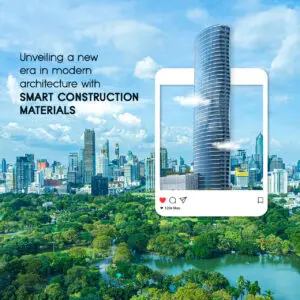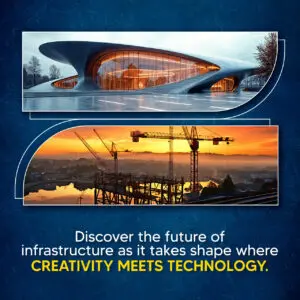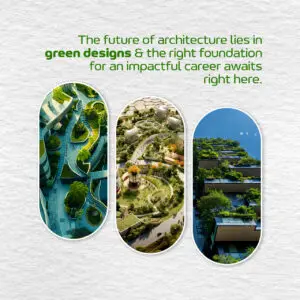
Modern cities, while symbols of progress and opportunity, are also becoming cautionary tales of unchecked growth.
- Space crunch, overwhelming congestion and shrinking green cover are now everyday urban realities.
- Poor drainage systems, unplanned land slopes and faulty infrastructure have made even metropolitan areas vulnerable to severe waterlogging during monsoons.
- The air grows more polluted, sunlight barely reaches street level in dense zones, and vertical growth often comes at the cost of visual harmony and liveability.
- With roads choked by traffic and skyline aesthetics disrupted by haphazard skyscrapers, the need for conscious urban design has never been more urgent.
In response, today’s architects and urban planners are no longer focused on building more, but building better.
By rethinking land use, incorporating climate-responsive design and embracing nature-integrated planning, they are redefining how cities are imagined, developed, and experienced for a sustainable tomorrow.
Foundations of Sustainable Urban Planning: Principles Every Architect Should Know
At the heart of sustainable urban planning lie resilient, inclusive & environmentally viable functional aspects of Architecture that are changing cities.
Key principles such as walkability ensure that essential services are accessible on foot, reducing dependence on vehicles and lowering carbon emissions.
Mixed land use fosters vibrant communities by integrating residential, commercial, and recreational spaces within proximity, encouraging social interaction and efficient land utilisation.
Ecological balance emphasises the integration of natural ecosystems into the urban fabric. Be it through green corridors, water bodies, or biodiversity zones, they maintain environmental health.
Resource efficiency, another cornerstone, advocates for optimal use of energy, water, and materials through smart technologies and passive design strategies.
Importantly, inclusive design ensures that urban spaces cater to people of all ages, abilities, and socio-economic backgrounds.
Green Architecture: Modern Techniques Transforming Urban Landscapes
Nowadays, cities are becoming living laboratories of sustainable innovation, as architects deploy cutting-edge techniques to combat environmental degradation and urban stress.
Passive design strategies, such as optimal orientation, natural ventilation and thermal massing, significantly reduce energy consumption by leveraging local climate conditions instead of relying on mechanical systems.
Green roofs and vertical gardens improve insulation and air quality, while managing rainwater and reducing the urban heat island effect.
The shift towards energy-efficient buildings equipped with solar panels, smart lighting systems and high-performance glazing reflects a broader commitment to net-zero goals.
Climate-responsive planning ensures that structures are designed with considerations like sun paths, wind direction, and rainfall patterns, making buildings more adaptive and less resource-intensive.
Use of smart materials like self-healing concrete, low-VOC paints and recycled composites is transforming the construction process as part of sustainable urban planning.
Global Benchmarks and Local Innovations: Case Studies in Sustainable Planning
Cities and metropolises across the globe are pioneering sustainable urban planning models that will sustain people in the coming generations.
Copenhagen, often hailed as the world’s greenest city, integrates extensive cycling infrastructure, renewable energy systems, and waterfront regeneration projects to promote both environmental and social sustainability.
Singapore, with its “City in a Garden” vision, incorporates vertical greenery, efficient public transport, and water-sensitive urban design, setting a gold standard for urban ecology.
Closer to home, Indian examples are gradually emerging with region-specific innovations.
Auroville, an experimental township in Tamil Nadu, emphasises low-impact living through earthen architecture, solar energy, and community-based planning.
Lavasa, despite controversies, demonstrated early efforts in building a planned hill city focused on walkability and mixed-use spaces.
Pune’s Smart City Mission is reimagining urban mobility, water management, and digital governance in select zones to promote sustainable urban living.
Exposure of Young Architects to Hone Their Skills in Sustainable Urban Planning
Young architects stand at the forefront of sustainable urban planning all over the world.
Participating in global design challenges like the Solar Decathlon, UN-Habitat’s Urban Thinkers Campus exposes them to real-world problems and encourages innovative, eco-sensitive solutions.
In India, platforms like the Council of Architecture’s NIASA Thesis Awards and Ethos India design competitions open doors for young minds to explore sustainable ideation, policy thinking, and green building practices.
NASA’s 3D-Printed Habitat Challenge and initiatives by The Indian Green Building Council (IGBC) Student Chapters encourage critical exploration of eco-conscious technologies and inclusive urban models.
Many architecture schools now embed sustainability studios, urban ecology labs, and research fellowships to inspire youth-led community initiatives like designing low-cost housing, building rainwater harvesting systems or revitalising neglected public spaces.
At OmDayal Group of Institutions, we foster creativity, awareness and adaptive thinking of young architects.
With access to digital tools, climate data and interdisciplinary knowledge, our students are emerging as professionals with the advantage of integrating sustainability from the ground up.
By endorsing innovation through hands-on projects, industry exposure and future-focused curriculum, we prepare them to lead the way in sustainable urban planning; building resilient, responsible cities of tomorrow.
Sources:
- https://www.re-thinkingthefuture.com/technologies/gp1547-the-impact-of-sustainable-architecture-on-urban-development/#
- https://www.ierek.com/news/urban-planning-and-sustainable-architectural-development/#
- https://medium.com/qlab-think-tank-gmbh/green-architecture-how-can-sustainable-urban-planning-make-cities-more-livable-290f6ffa789b
- https://www.whereisthenorth.com/article/10-sustainable-urban-design-strategies-with-examples
- https://impakter.com/sustainable-buildings-pioneering-a-green-revolution-in-urban-design/#




